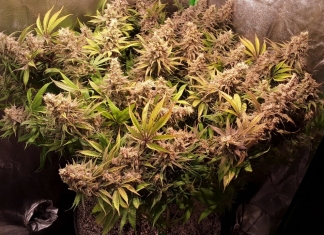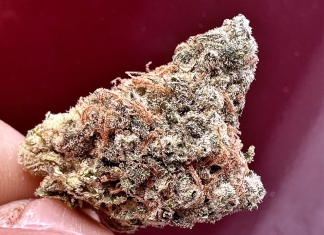Ernest Misko was using medical marijuana to treat his chronic back pain when his elderly cat, Borzo, started having difficulty walking, so he decided to feed the cat a cannabis tincture. Within a few days, he reported that Borzo was moving around much better and seemed to feel less pain.
Misko’s story was published in the Journal of the American Veterinary Medical Association, along with similar success stories of pet owners giving cannabis to their dogs or cats for ailments. But while there is plenty of anecdotal evidence that the plant seems to help our furry companions in ways similar to those in which it can help us, there’s little research to prove it. To help push the thirst for more information, the Wheat Ridge Animal Hospital held a free forum for pet owners and veterinarians on Tuesday, January 23, to discuss how medical marijuana and CBD products can help pets.
“Many owners use it for quality of life, or when the traditional treatments aren’t working,” Sarah Gradilla, an associate veterinarian at Wheat Ridge Animal Hospital, said during the lecture.
All vertebrates have an endocannabinoid system, which produces cannabinoids inside the body while also having receptors for them from external consumption. The system helps maintain both cell and body homeostasis and can affect carcinogens, pain, memory and inflammation, among other things. Dogs’ endocannabinoid receptors are similar to those of humans, according to Gradilla, though their receptors tend to be concentrated in certain parts of the brain, which increases their sensitivity to the toxicity of certain cannabinoids, including THC.
Most research on the subject in the United States has been limited to pre-clinical trials with lab animals for human research, Gradilla said, due to marijuana’s federal classification as a Schedule I drug. That hasn’t stopped some pet owners from trying it on their own, though. A survey published in 2016 found that about half or more of the respondents saw medical marijuana improve their pets’ conditions.
The survey, published in the Journal of the American Holistic Veterinary Medical Association, was conducted by a team from the Colorado State University College of Veterinary Medicine in partnership with hemp-treat company Canna Pet. Of the 632 people surveyed, about 72 percent reported using a hemp product with their dogs, and about 16 percent reported using it with their cats. Just over 64 percent of dog owners and 66 percent of cat owners felt that the hemp products had helped their pets either moderately or a great deal. Hemp helped 49 percent of dogs with anxiety, as reported by their owners, and helped 56 percent of cats with inflammation. The most common reported side effects were sedation and overactive appetites, which reached around 20 percent for dogs and 15 percent for cats.
Only 274 respondents — about 43 percent — said they had talked with their vets about using the products. Of those, just under 62 percent said their vets had responded positively. “That is kinda mixed results,” Gradilla said about the survey, but added that it can serve as a foundation for future research.
CSU is currently investigating whether CBD can help dogs that suffer from canine epilepsy and osteoarthritis. Using thirty dogs, the researchers assigned two different doses in a variety of methods. All of the dogs got diarrhea, but the duration, onset and severity didn’t appear to correlate to the dosage. The sole abnormal lab finding, according to Gradilla, was elevated alkaline phosphatase levels in some of the dogs that received CBD through an oil tincture at two points.
Ultimately, the study found that CBD was tolerable for dogs and gained support to move to a second clinical trial that will look at 34 dogs with epilepsy and 24 dogs with osteoarthritis. Research is important, Gradilla said, because of the legalization of recreational marijuana in a number of states, but veterinarians are not legally allowed to prescribe or recommend it. This lack of research and oversight has led to a “buyer beware” market, she said, with a number of companies popping up online that don’t thoroughly label their products or sometimes incorrectly label them. Because of its lack of federal oversight, CBD is also occasionally marketed for ridiculous issues, she said, like to help cats not be afraid of the litter box or to keep them meowing all the time.
How to Administer Medical Marijuana to Your Pet
“Because there is a lack of adequate control of dosing, this can result in overdosing, but mostly under-dosing,” Gradilla said. For pet owners looking to dabble in marijuana to help aching pets, she believes that oil-based products have the best absorption rate. After reviewing three CBD websites targeting pet owners, she found that Rx Vitamins provided the most information about formulations, side effects and dosing.
It’s important to look at the amount of CBD in each dosage, according to Gradilla, as a 300-milligram capsule could contain only a small percentage of CBD. The extraction process is also important. Extraction by CO2 is considered safest for animals, as opposed to using solvents like ethanol, which can be toxic for smaller animals. While not much is known about dosing so far, Gradilla said one of the suggested approaches for administering hemp-derived CBD products goes as follows:
•Administer 0.1 to 0.5 milligrams of CBD for every kilogram your pet weighs twice per day.
•Start low, and increase the dosage every two weeks until your pet sees therapeutic effects.
•Stay with your pet for a few hours after administering medicine to ensure your pet tolerates it.
•Mix as much THC in with the CBD as the animal is comfortable with – but take it very slow.
•Some vets recommend starting with a 20:1 ratio of CBD to THC, and adding slightly more THC each time until it reaches a therapeutic level.
“Medical marijuana itself is a very individualized medicine,” she said, adding that physiologies in humans and animals can change over time, so the dosing needs could as well. While most people lean toward non-psychoactive CBD for medical purposes, as it’s been shown to treat inflammation, anxiety, pain, sleep issues and epilepsy, Gradilla said that using a whole plant product is usually more effective. There are more than 500 compounds in the cannabis plant, and they appear to create an “entourage effect,” working together to produce the best results, according to numerous doctors and scientists.
An Israeli study Gradilla cited found that when lab mice were given only purified CBD, the effect had a bell-shaped curve and there was a very narrow therapeutic window. But when the mice were given plant extracts with low amounts of THC and high amounts of CBD, there was a clear correlation with the therapy.
While veterinarians can’t prescribe marijuana to help pets, the Colorado Veterinary Medical Association has said that they are obligated to educate pet owners on the uses and risks involved with medical marijuana, according to Gradilla, and the American Holistic Veterinary Medical Association has encouraged more research into safety and dosing. “They feel that there is a growing body of evidence that this medicine can help pain and chronic illness and contribute to a to a quality of life,” Gradilla said of the governing bodies for Colorado veterinarians.














